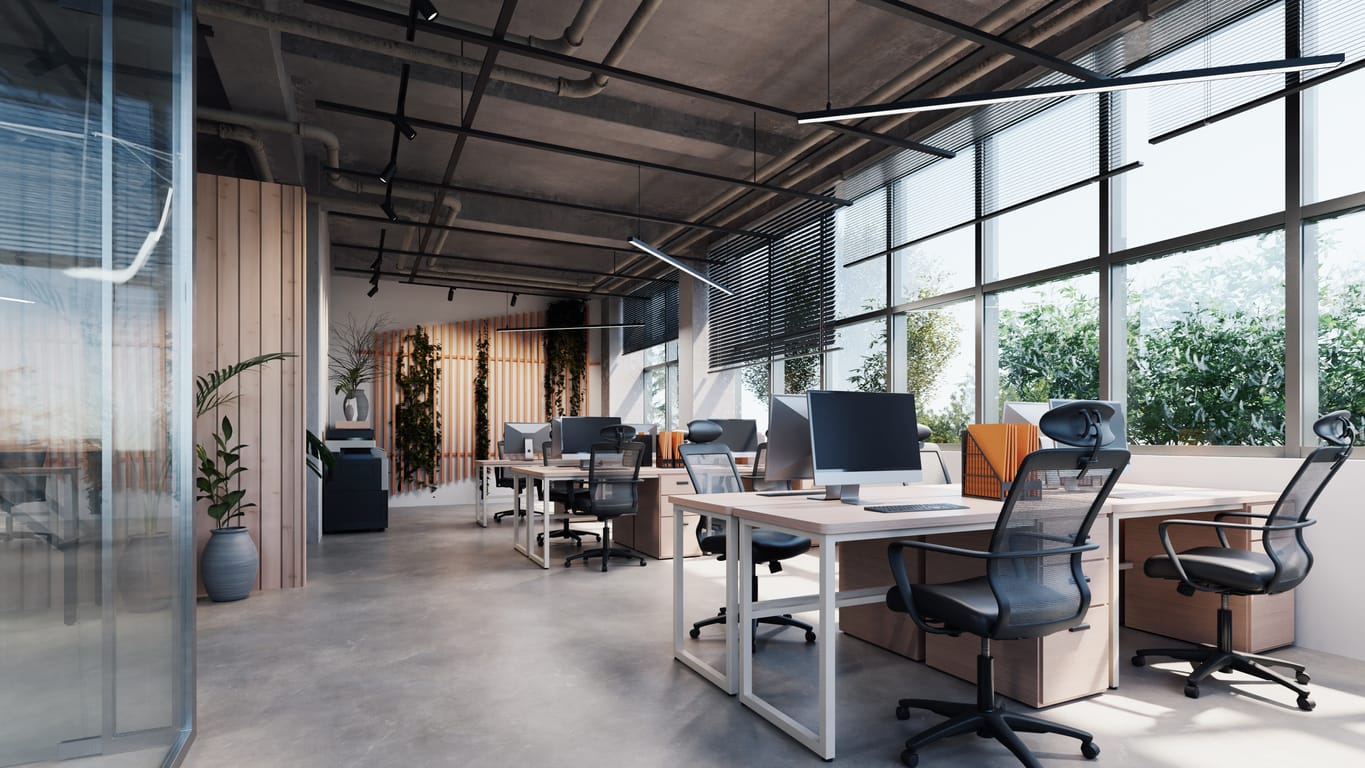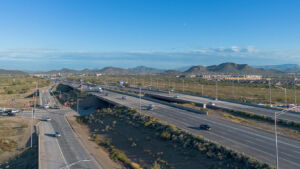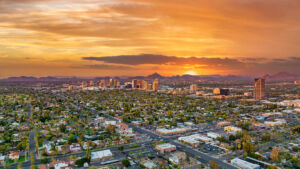As we reimagine the workspace in an era of unprecedented change, we’ve gathered insights from industry experts, including CEOs and Founders, to share their visions for the future of office design. From designing for digital nomads to the integration of augmented and virtual reality, explore the thirteen innovative concepts that are poised to transform our work environments. When it comes to the future of office design, here are 13 predictions from industry leaders:
LEARN MORE: Headwinds persist in Phoenix office recovery, report shows
- Designing for Digital Nomads
- Nature-Infused Employee Wellness
- Standing Desks Gain Popularity
- Flexible Seating for Varied Styles
- Warm Earth Tones in Maternity Clinics
- Adaptable Workspaces With Biophilic Elements
- Hyper-Realistic Video Communication Tools
- Activity-Based Working for Flexibility
- Acoustic Meeting Pods and Café Ambiance
- Dynamic Workplaces Foster Digital Collaboration
- Natural Features for Health and Productivity
- Hot Desking Encourages Workspace Flexibility
- Immersive Collaboration With VR and AR
Designing for Digital Nomads
Adaptability, portability, and cozy working spaces have been the ongoing themes in office design for the past few years, and they are not going to die down anytime soon. With rapid innovations in the market and rapid changes in how people work and interact, it is no surprise that future offices will be designed with the digital nomad in mind.
Future offices with a café-like ambiance alongside biophilic design will help reshape offices in the future. Greeneries, gardens, and breakout spaces can cater to various hobbies and employee needs will most likely be popular additions in offices for the coming years.
Joe Ferguson, Architectural Joiner, Skirtings R Us
Nature-Infused Employee Wellness
Already, the pandemic has ensured that, in terms of office designs, the flexibility box has been checked. However, in the future, a more flexible office design that would better support employees’ work patterns will be incorporated.
This will be based on the understanding of nature’s calming effect and its ability to reduce stress, enhance focus, and promote longer concentration for employees in the workplace. Extra attention will be given to the furniture and the view of nature obtainable from and within the office space.
The future of office designs will undoubtedly be more employee-centered, targeted to better suit the employees’ need for flexibility, while also supporting employee wellness.
With the not-so-recent discovery of the rejuvenating effects of nature, especially regarding the promotion of employees’ mental health and its ability to increase work efficiency, employers will inevitably, as much as they can, bring nature into the workplace.
Grace Chisom, Marketing Manager, Check CPS
Standing Desks Gain Popularity
Standing desks are rising in popularity in offices across the world and will certainly continue to do so in the coming years. This stems from a growing awareness of the potential health benefits associated with reducing sedentary behavior and promoting more active work habits.
Many studies have found that prolonged sitting has been linked to various health issues, including obesity, cardiovascular disease, and musculoskeletal problems. Standing desks, however, offer an alternative to sitting for long periods, promoting movement and reducing sedentary behavior.
As more and more people continue to invest in both their mental and physical health, I do not doubt that standing desks will gain huge traction in the coming years.
Kate Jones, Account Assistant, Lumen SEO
Flexible Seating for Varied Styles
Flexible seating for different learning styles will become more standard. Gone will be the days when your desk is just your desk, and the days when you sit all day in the same spot. Offices will provide different spaces with different moods and equipment.
There will be standing desks, bean bags, sofas, open boardroom tables, soundproofed rooms, and more.
Jarir Mallah, HR Manager, Ling App
Warm Earth Tones in Maternity Clinics
We opt for soft, warm earth tones for all our office interiors for good reason. As a maternity clinic with a vested interest in providing our patients with the most comfortable, organic, and natural experience, that should always be reflected in how we maintain and curate our spaces.
In the waiting room or the examination room, we must lead with soothing tones to reflect our intentions and capabilities to soothe and serve our clients where they are in their own lives.
As a result, our offices enjoy a relaxed, down-to-earth culture that helps keep us grounded in our work. It’s a design decision that ultimately benefits both our teams and our patients in the long run, and other brands should follow suit as part of tailoring their physical and digital spaces to drive the best experiences for team members and customers alike.
Joanne Demeireles, CXO, Oula Health
Adaptable Workspaces with Biophilic Elements
I need to say I’m convinced that the future of office design is as dynamic as the global market we operate in. Adaptable workspaces are the new kings of office design, and those static, monolithic office layouts have become as outdated as fax machines.
The future will be about spaces that shape-shift faster than a chameleon. Then there’s the focus on well-being and inclusivity. Let me tell you, it doesn’t mean throwing in a plant here and a comfy chair there. Companies need to provide spaces that genuinely make people feel good—physically and mentally. It can be achieved with biophilic elements that bring a slice of nature indoors, and quiet zones that offer a sanctuary for those who need a break from the buzz.
The future lies in creating an office that doesn’t just look good on Instagram but feels good to be in. Technology integration is also a critical aspect of future office design. With the rise of hybrid work models, offices need to be equipped with advanced digital infrastructure like high-quality video conferencing facilities, smart boards, and integrated communication systems.
We are constantly redefining what ‘going to work’ actually means, so the future office design should be open and ready to adapt.
Lukasz Koszyk, Head of Business Development, VisaFly
Hyper-Realistic Video Communication Tools
As businesses continue to move to the hybrid world, some of those communication innovations will become office mainstays.
Looking at something like Google’s Project Starline and similar technologies, we’re seeing major advancements that make it seem like you’re sitting in the same room with someone, no matter where you’re located geographically. Using a screen and multiple camera sensors, you can create a real ‘presence’ that’s so much better than the current Zoom or Google Meet standards.
I see future offices decked out with more hyper-realistic video communications and other tools to bring the traditional office feel to remote work.
Robert Kaskel, Chief People Officer, Checkr
Activity-Based Working for Flexibility
The future of office design is likely to be influenced by evolving work trends and a focus on creating flexible, collaborative, and employee-centric environments. One innovative concept gaining traction is the implementation of “activity-based working” (ABW).
ABW emphasizes creating diverse workspaces tailored to specific tasks rather than assigning fixed desks. It encourages mobility, flexibility, and a choice of work settings, such as collaborative zones, quiet spaces, and standing desks.
This concept aims to enhance employee well-being, productivity, and collaboration by providing a variety of work environments that suit different work styles and tasks.
Khunshan Ahmad, CEO, InsideTechWorld
Acoustic Meeting Pods and Café Ambiance
In the realm of future office design, the emergence of acoustically isolated meeting pods stands as a pivotal innovation expected to flourish in the coming years. These enclosed spaces, equipped with advanced audio-visual capabilities, are envisioned to reshape office landscapes, offering multifaceted meeting opportunities within compact and soundproof environments.
A concurrent trend expected to gain momentum involves transforming traditional office spaces into café-like environments. This shift aims to infuse a relaxed and inviting ambiance reminiscent of cafes, fostering a more casual and collaborative work culture. By integrating elements such as cozy seating, communal work areas, and ambient lighting, office spaces seek to emulate the welcoming atmosphere of cafes, promoting creativity, social interaction, and a comfortable yet productive work environment.
This amalgamation of acoustically optimized meeting pods and café-inspired office spaces forecasts a future where work settings prioritize adaptability, collaboration, and employee well-being in innovative and inviting environments.
Andrew Chung, Founder, bestcafedesigns.com and spacesave.co
Dynamic Workplaces Foster Digital Collaboration
Companies are making accommodations for the work culture adopted during the pandemic.
Dynamic workplaces, with a mix of different environments, are the future. These areas will lend themselves to collaborative work, especially digitally. They will also give you some comforts of working from home. Employees will have more flexibility and will be less tied to a small cubicle.
Workers will have more flexibility in choosing their environment. Formal spaces will allow for more focused tasks, while informal areas will be great for meetings or more relaxed work.
Andrew Johnson, Digital Strategist, Giveaways
Natural Features for Health and Productivity
In natural design, natural features are brought into the workplace to make it feel more natural and healthy. Bringing aspects of nature into the workplace can have a significant effect on people’s health, productivity, and creativity.
This idea stems from the belief that people are naturally connected to nature. It aims to let in as much natural light as possible and ensure there is enough airflow to make the area bright and airy. Large windows, skylights, and smart lighting systems that mimic the patterns of natural light are all examples of this.
Biophilic features in the workplace have been shown to reduce stress, improve mood, and enhance overall well-being. It is known that being in nature can help you focus, be more creative, and think more clearly.
Tim Griffiths, CEO, Initial Interiors
Hot Desking Encourages Workspace Flexibility
The future of office design is evolving, and as an entrepreneur, I foresee a rise in flexible workspace concepts. “Hot desking,” or shared workspaces, where employees choose different desks each day, will gain traction. This fosters collaboration, adaptability, and a more dynamic work environment.
It also saves space and accommodates remote work trends, promoting a balance between collaboration and individual focus. Such innovative designs adapt to the changing needs of businesses, encouraging creativity and teamwork while embracing the modern workforce’s desire for flexibility and autonomy in the work setting.
Aqsa Tabassam, Business Development Manager, Walk In Tub
Immersive Collaboration with VR and AR
One innovative concept that I expect will gain traction in the coming years is the development of immersive collaboration spaces. These spaces will use virtual reality (VR) and augmented reality (AR) technologies to create a seamless blend of the physical and digital worlds.
Imagine this: Employees put on VR headsets and enter a virtual workspace where they can interact with colleagues located anywhere in the world. Teams can brainstorm ideas on a virtual whiteboard, work on 3D models together, and even take part in immersive training simulations. This technology has the potential to revolutionize collaboration and communication in the future office.
While still in its early stages of development, immersive collaboration technology has the potential to drastically change the way we work. As VR/AR technology becomes more affordable and accessible, we can expect to see these spaces become increasingly common in offices around the world.
Jianwei Kapp, Marketing Coordinator, Achievable




